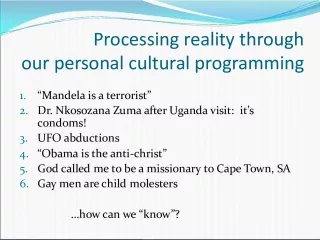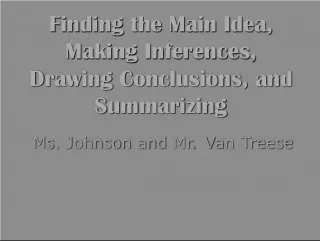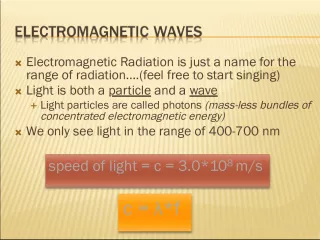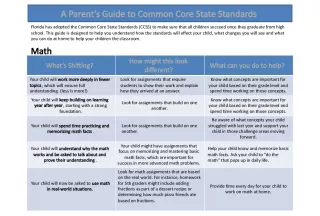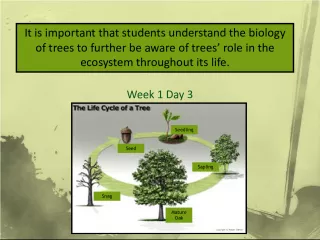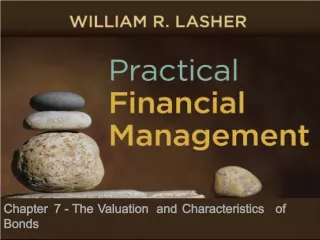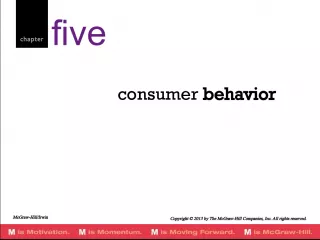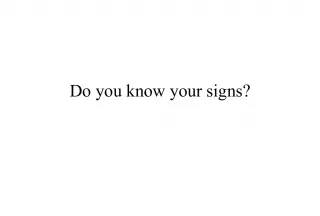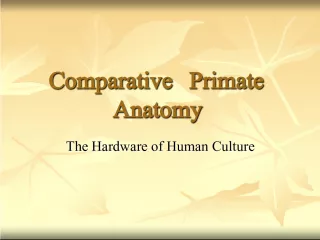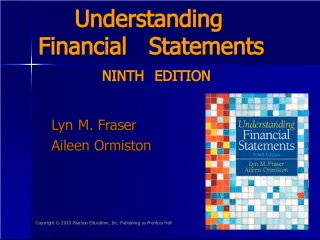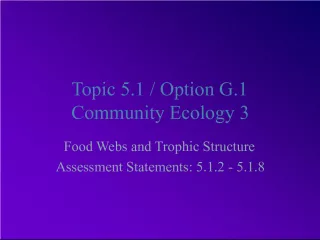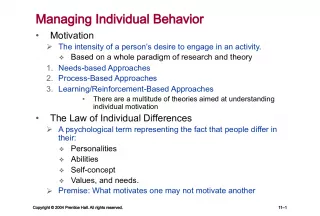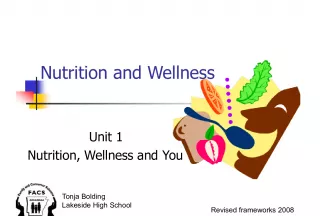Understanding Immunizations
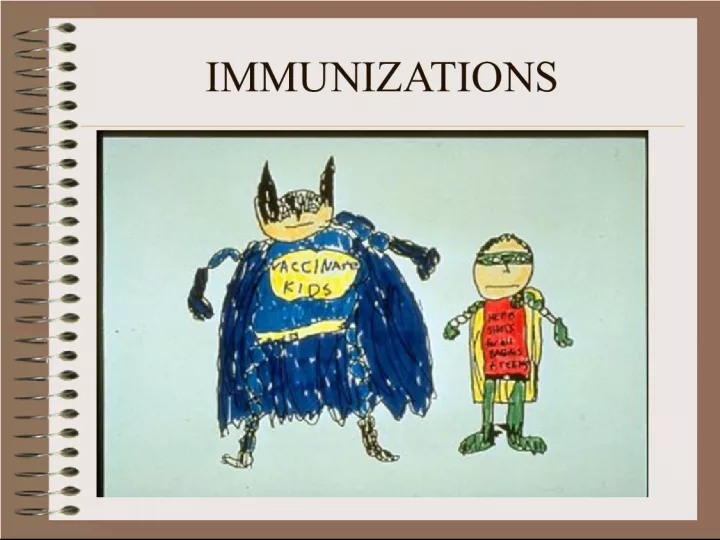

Learn about active and passive immunization, and how they provide protection against infectious agents through antibody production and administration.
- Uploaded on | 3 Views
-
 jacksingh
jacksingh
About Understanding Immunizations
PowerPoint presentation about 'Understanding Immunizations'. This presentation describes the topic on Learn about active and passive immunization, and how they provide protection against infectious agents through antibody production and administration.. The key topics included in this slideshow are . Download this presentation absolutely free.
Presentation Transcript
2. DEFINITION Immunization is the process of inducing immunity artificially by either vaccination ( active immunization ) or administration of antibody ( passive immunization ). ACTIVE IMMUNIZATION Stimulates immune system to produce antibodies and cellular immune responses that protect against infectious agent.
3. PASSIVE IMMUNIZATION Provides temporary protection through administration of exogenously produced antibody such as immune globulin. Also occurs naturally through transplacental transmission of antibodies to a fetus.
4. Vaccine: A product of weakened or killed microorganism (bacterium or virus) given for the prevention or treatment of infectious diseases Toxoid : A modified bacterial toxin that has been made nontoxic but retains the capacity to stimulate the formation of antitoxin.
5. The major constituents of vaccines 1. Active immunizing agent Single antigen : tetanus , diphtheria toxoid Complex antigens : live viruses,killed bacteria 2. Suspending fluid Sterile water or saline Tissue culture fluid : egg Ag, gelatin 3. Preservatives , stabilizers , antibiotics Added to prevent bacterial growth / stabilize Ag Thiomersol : mercurial subs. Neomycin , streptomycin
6. 4. Adjuvants Aluminium salt added to enhance immune response Esp. vaccines with inactive microorgs eg. Hep B , Diph Tet toxoids
8. VACCINES ON SCHEDULE 1. Hep B : Hepatitis B( inactivated recombinant) 2. DTaP : Diphtheria & Tetanus toxoid and acellular pertussis vaccine ( inactive) 3. DT & Td .: Diphtheria & Tetanus toxoid 4. Hib : Haemophilus influenzae b Polysaccharide protein conjugate 5. IPV : Inactivated poliovirus vaccine 6. PCV7 : Pneumococcal conjugate vaccine 7. 23PS : Pneumococcal polysaccharide
9. 8. MMR : Measles mumps rubella live vaccine 9. Varicella : Chicken pox live vaccine 10. Influenza : Inactivated vaccine 11. Hepatitis A : Inactivated vaccine
10. Simultaneous Administration General Rule There are no contraindications to simultaneous administration of any vaccines.
11. Combination Two live injected All other Minimum Interval 4 weeks None Spacing of vaccine combinations not given simultaneously
12. Interference Between Live Virus Vaccines Separated by <28 days Retrospective cohort study of 115,000 children vaccinated in 2 HMOs during January 1995 through December 1999 Risk of breakthrough varicella 2.5 times higher if varicella vaccine given <30 days following MMR No increased risk if varicella vaccine given simultaneously or > 30 days after MMR MMWR 2001;50(47):1058-61
13. Intervals Between Doses General Rule Increasing the interval between doses of a multi-dose vaccine does not diminish the effectiveness of the vaccine. Decreasing the interval between doses of a multi-dose vaccine may interfere with antibody response and protection.
14. Minimum Intervals and Ages Vaccine doses should not be given at intervals less than the minimum intervals or earlier than the minimum age
15. Violation of Minimum Intervals or Minimum Age ACIP recommends that vaccine doses given up to four days before the minimum interval or age be counted as valid Immunization programs and/or school entry requirements may not accept all doses given earlier than the minimum age or interval
16. Extended Interval Between Doses Not all permutations of all schedules for all vaccines have been studied Every study of extended intervals have shown no significant difference in final titer It is not necessary to add doses or restart the series because of an extended interval between doses
18. Vaccine Adverse Reaction Adverse reaction extraneous effect caused by vaccine "side effect" Adverse event any event following a vaccine may be true adverse reaction may be only coincidental
19. Vaccine Adverse Reactions Local pain, swelling, redness at site of injection common with inactivated vaccines usually mild and self-limited
20. Vaccine Adverse Reactions Systemic fever, malaise, headache nonspecific may be unrelated to vaccine
21. Live Attenuated Vaccines Must replicate to produce immunity Symptoms usually mild Occur after an incubation period (usually 7-21 days)
22. Vaccine Adverse Reactions Allergic due to vaccine or vaccine component rare risk minimized by screening
23. Contraindication A condition in a recipient which greatly increases the chance of a serious adverse event.
24. Precaution A condition in a recipient which may increase the chance or severity of an adverse event, or May compromise the ability of the vaccine to produce immunity.
25. Contraindications and Precautions severe allergy to a prior dose of vaccine or to a vaccine component encephalopathy following pertussis vaccine Permanent contraindications to vaccination:
26. Contraindications and Precautions Condition Allergy to Component Encephalopathy Pregnancy Immunosuppression Severe illness Recent blood product Live C --- C C P P Inactivated C C V V P V C=contraindication P=precaution V=vaccinate if indicated
27. Invalid Contraindications to Vaccination Mild illness Antibiotic therapy Disease exposure or convalescence Pregnancy in the household Breastfeeding Premature birth Allergies to products not in vaccine Family history unrelated to immunosuppression Need for TB skin testing Need for multiple vaccines
28. Invalid Contraindications Minor Illness Low grade fever Upper respiratory infection Otitis media Mild diarrhea Only one small study has suggested decreased efficacy of measles vaccine in children with URI Findings not replicated by multiple prior and subsequent studies No evidence of increased adverse reactions
29. Screening Questions Allergies to food or medication? How is your child today? Any problem after last shots?
30. Screening Questions Problems with immune system Anyone in household with immune problems? Blood products in last year? Pregnant?
32. SPECIAL HOSTS IMMUNOCOMPROMISED Live vaccines are contraindicated Inactivated vaccines given per schedule
33. HOUSEHOLD CONTACTS Give MMR Vaccine virus is not transmitted Varicella also given Transmission of vaccine virus rare Disease if it develops is mild
34. Immunosuppression > 20 mg per day if wt >10 kg > 2 mg/kg per day NOT aerosols, topical, alternate day, short courses Corticosteroids
35. Recommendations for Routine Immunization of HIV-infected Children Vaccine Varicella MMR All others Asymptomatic Yes Yes Yes Symptomatic No No Yes Yes=vaccinate No=do not vaccinate Yes=vaccinate No=do not vaccinate
36. PATIENTS TREATED WITH IG / BLOOD PRODUCTS Depends on dose MMR / Varicella give at suggested intervals
37. PRETERM INFANTS Immunize per chronologic age Use regular vaccine dosage Exception Hepatitis B vaccine
38. PREGNANCY OF RECEPIENT Live viral vaccines are contraindicated Theoretical risk to fetus No cases actually observed with congenital rubella or varicella Termination of pregnancy is not routinely indicated
39. PREGNANCY OF MOTHER OR OTHER HOUSEHOLD CONTACT MMR vaccine : Vaccine virus not transmitted Varicella vaccine : Vaccine virus transmitted Frequency rare Mild / Asymptomatic infection
40. RECEPIENT IS BREASTFEEDING No vaccine is contraindicated Only rubella vaccine virus isolated from human milk.
41. EGG ALLERGIES MMR vaccine can be given without prior skin testing Influenza contraindicated if immediate hypersensitivity reaction to eggs
42. Vaccine Minimum age for first dose Minimum age from dose to dose Vaccine Minimum age for first dose Minimum age from dose to dose 2 to 3 3 to 4 DTaP 6 WKS 1 MONTH 1 MONTH 6 MONTHS Hib 6 WKS 1 MONTH 1 MONTH 2 MONTHS PCV7 6 WKS 1 MONTH 1 MONTH 2 MONTHS IPV 6 WKS 1 MONTH 1 MONTH 1 MONTH MMR 12 MONTHS 1 MONTH HBV BIRTH 1 MONTH 2 MONTHS VARICELLA 12 MONTHS 1 MONTH
43. Alex is a 1 month 25 day old infant who received his Hepatitis B #1 at birth and is here for a well visit. Is he due for any shots and can he get them today ?
44. 2 month visit : DTaP#1 Hib#1 IPV #1 PCV7#1 Does he have to return in 5 days for these? Can he get HBV #2 today ?
45. Alex comes back for a sick visit at age 2 months 20 days.( 25 days later) He has a stuffy nose and is coughing with an axillary temperature of 99 F. Can he get his DTaP #2, Hib # 2, IPV #2 and HBV #3 today ? Mom is keen on getting them as it will save her an extra trip.
46. 4 month visit DTaP # 2 Hib # 2 IPV# 2 PCV7 # 2
47. Alex comes back at age 4 months. His mother reported that his thigh was red and swollen after his previous shots. There is a strong family history of allergies including penicillin allergy. His older brother Josh had a bad reaction after DTaP. Joshs whole leg had swelled up and he had run a high fever too. Can Alex still get his shots ?
48. ADVERSE REACTIONS to DTaP Minor 2 to pertussis component Redness edema pain induration at inj site drowsiness fussiness crying Anorexia vomiting slight to moderate fever
49. MINOR REACTIONS Usually occurs within several hours of immunization Subsides spontaneously without sequelae Much less common with DTaP than DTP NOT CONTRAINDICATIONS
50. ALLERGIC REACTION Anaphylaxis : 2 cases per 100,000 IS A CONTRAINDICATION Transient urticarial reactions Not anaphylactic ( IgE ) unless seen within minutes Serum sickness reaction Unlikely to recur NOT A CONTRAINDICATION
51. Contraindications to DTaP 1. Immediate anaphylaxis to vaccine 2. Encephalopathy within 7 days Coma , decreased conciousness prolonged sx 3. Progressive neurologic disorder infantile spasms, progr. encephalopathy uncontrolled sx
52. PRECAUTIONS These conditions may increase chance of adverse events Do not cause permanent sequelae Weigh risk versus benefit Community outbreak, foreign travel
53. PRECAUTIONS for DTaP 1. Seizure fever within 3 days of DTaP Incid 1 in 1750 for DTP 2. HHE or hypotonic-hyporesponsive episode : Collapse or shock like state within 48 hrs Incid 1 in 1750 for DTP 3. Fever >= 40.5 C ( 104.8 F ) within 48 hrs. Incid 0.3%
54. PRECAUTIONS for DTaP 4. Persistent severe inconsolable screaming / crying for three or more hours within 48 hrs.
55. DTaP NOT CONTRAINDICATED F/H of Seizures F/H of SIDS F/H of adverse reactions to DTaP Stable neuro conditions CP, well controlled sx, develop delay Hx of PCN allergy ,relatives with allergy
56. IN PERSPECTIVE DISEASE Diphtheria Death 1 in 20 Tetanus Death 3 in 100 Pertussis Pneumonia 1 in 8 Encephalitis 1 in 20 Death 1 in 200 VACCINE Continous crying with full recovery 1 in 100 Convulsions or shock then full recovery 1 in 1750 Acute encephalopathy 0-10.5 in 1,000,000 Death none proven
60. Alex comes back at 6 months for a well visit. What shots does he need ?
61. 6 MONTHS Hep B # 3 ( Min age 6 mo & 4mo after 1 st ) DTaP # 3 Hib # 3 IPV # 3 PCV7 # 3
62. Alex will be 1 year old tomorrow. Mom does not want to give him shots on his birthday so can he get them today? Also she has heard that MMR has egg in it and he breaks out with hives when he eats eggs. Can he get the MMR ?
63. 1 YEAR OLD Hib # 4 ( Min age 1 yr ;2 mo after 3 rd dose) MMR # 1 ( Min age 1 yr ) Varicella ( Min age 1 yr ) PCV7 # 4 ( 2 mo after 3 rd dose )
64. Live attenuated Measles & Mumps : Chick embryo cell culture Does not have significant egg white ( ovalbumin ) cross reacting protein Rubella : Human diploid cell culture MMR Vaccine
65. ADVERSE EVENTS MINOR ( after 7-12 days ) 1. Fever >= 39.4 C ( 103 F ) Lasts 1-5 days O/w Asymp 5-15 % 2. Transient rash 5%
66. ADVERSE EVENTS Moderate to severe 1. Febrile seizures Simple feb sx Not at increased risk of epilepsy 2. Transient thrombocytopenia 2-3 weeks after ( upto 2 months ) 1 in 25,000 1 in 40,000 Past/H of tcytopenia / vaccine tcytopenia 3. Encephalitis / Encephalopathy < 1 in million
67. CONTRAINDICATIONS 1. Anaphylaxis to prior vaccine 2. Anaphylactic neomycin or gelatin allergy 3. Pregnancy 4. Immunocompromised states
70. Alex returns for his 15 month check up. Mom says that he broke out with chicken pox 3 weeks after his last set of shots. She was worried because her nephew who has leukemia was staying with them at the time.
71. VARICELLA MISCONCEPTIONS 1. Chicken pox is a mild disease FACT 10,000 Hospitalizations and 100 deaths / year 2/3 rds the admissions and half the deaths occur in children Most imp risk factor for invasive GAStrep
72. 2. Vaccine is not very effective FACT : 85-90 % effective during outbreaks 100% effective agnst severe disease Mild varicella like illness in 1-4% of immunized kids with rapid recovery Rash so mild that it may resemble insect bites Child is potentially infectious
73. 3. Immunity does not last lifelong FACT Protection for at least 11 years in US and 20 years in Japan Other live viral vaccines : Immunity lasts a lifetime
74. 4. Is it a safe vaccine ? YES Reactions are mild Minor inj site 20% Local rash 3-5 % Gen varicelliform rash after 5-26 days in 3-5 % Zoster like illness 2.6 / 100,000 vaccine doses distributed
76. 15 MONTHS 18 MO DTaP # 4
77. 4-6 YEARS ( PRE KINDERGARTEN ) DTaP # 5 IPV # 4 MMR # 2
78. 11 yrs Td Booster every 10 yrs
79. TAKE HOME MESSAGES Vaccines are safe Vaccines are very effective Educate yourself so that you do not propagate misconceptions Ask yourself Is the child more likely to die of the vaccine or the disease? before you with hold any vaccines Threat from vaccine preventable diseases is real
80. Vaccination is one of the greatest achievements of medicine It has spared millions of people the effects of devastating disease



